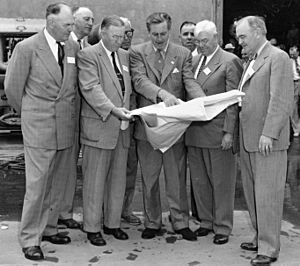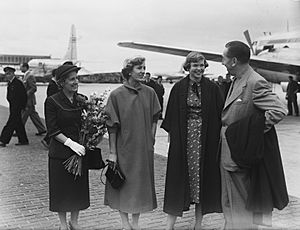Walt Disney facts for kids
Quick facts for kids
Walt Disney
|
|
|---|---|
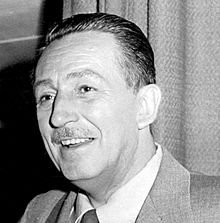
Walt Disney on January 1, 1954
|
|
| Born |
Walter Elias Disney
December 5, 1901 |
| Died | December 15, 1966 (aged 65) Burbank, California, U.S.
|
| Cause of death | Lung cancer |
| Resting place | Forest Lawn Memorial Park, Glendale, California, U.S. |
| Nationality | American |
| Education | McKinley High School, Chicago Academy of Fine Arts |
| Occupation | Co-founder of The Walt Disney Company, formerly known as Walt Disney Productions |
| Years active | 1920–1966 |
| Home town | Chicago, Illinois |
| Political party | Republican |
| Board member of | The Walt Disney Company |
| Spouse(s) | Lillian Bounds (1925–66; his death) |
| Children | Diane Marie Disney Sharon Mae Disney |
| Parent(s) | Elias Disney Flora Call Disney |
| Relatives | Ronald William Miller (son-in-law) Robert Borgfeldt Brown (son-in-law) Roy Edward Disney (nephew) |
| Family | Herbert Arthur Disney (brother) Raymond Arnold Disney (brother) Roy Oliver Disney (brother) Ruth Flora Disney (sister) |
| Awards | 7 Emmy Awards 22 Academy Awards Cecil B. DeMille Award |
| Signature | |
 |
|
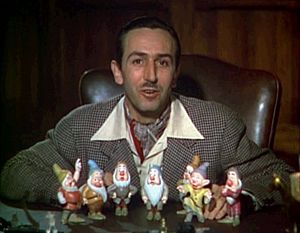
Walter Elias Disney (December 5, 1901 - December 15, 1966) was an American business leader, animator, and cartoonist. He was also a producer, screenwriter, and voice actor. Walt Disney was very important in the American animation industry. People around the world see him as an icon and a generous person. He is famous for his big impact on entertainment in the 20th century.
Walt Disney, along with his brother Roy Disney, started Walt Disney Productions. This company is now known as The Walt Disney Company. As a talented animator and business owner, Disney was known for making films and creating amazing shows. He also came up with new ideas for animation and theme parks. He and his team created many famous characters, like Mickey Mouse. Walt Disney even provided the original voice for Mickey Mouse.
He won 22 Academy Awards from 59 nominations. This is more awards and nominations than anyone else in history. He also won four special honorary Academy Awards. Disney also received seven Emmy Awards. He gave his name to the Disneyland and Walt Disney World Resort theme parks in the United States. There are also Disney resorts in Tokyo, Paris, and Hong Kong. Walt Disney died on December 15, 1966, from lung cancer.
Contents
Walt Disney's Early Life
Walter Elias Disney was born on December 5, 1901. His birthplace was at 2156 North Tripp Avenue in Hermosa, Chicago, Illinois. His father, Elias Disney, had Irish-Canadian family roots. His mother, Flora Call Disney, had German and English family.
His great-grandfather, Arundel Elias Disney, came from Ireland. The family name "Disney" came from a French name, "d'Isigny." This name was changed to "Disney" when his ancestors moved to England.
Walt Disney's Amazing Career
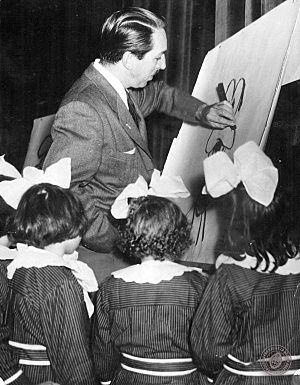
When Walt Disney was in high school, his family moved to Chicago. He took art classes at the Chicago Art Institute. He also drew cartoons for his school newspaper. When he was 16, Disney wanted to help in World War I. He was too young for the army, so he joined the Red Cross. He spent a year driving ambulances in France.
Creating Famous Cartoon Characters
Disney's most famous creation is the cartoon character, Mickey Mouse. Walt Disney himself was the voice of Mickey Mouse for many years. Other well-known characters he created include Donald Duck, Minnie Mouse, and Pluto.
Early in his career, Disney was once fired from a newspaper company. They said he lacked creativity. He started as a cartoonist in the 1920s. He first created a character called Oswald the Lucky Rabbit. But he lost the rights to Oswald because of a contract problem. After that, he created Mickey Mouse.
Making Groundbreaking Animated Films
Disney started the Walt Disney Studios. He then created the first full-length animated movie. This movie was Snow White and the Seven Dwarfs, released in 1937. The movie was a huge success. The money from Snow White helped Disney make many more cartoons and movies.
Some of these famous films include:
After World War II, new animated and live-action films were released. These included Cinderella (1950), Peter Pan (1953), and Mary Poppins (1964). Mary Poppins won five Academy Awards. Walt Disney hosted "The Wonderful World of Disney." This weekly variety show featured Disney cartoons and live-action skits.
Building Theme Parks
In the 1950s, Disney created Disneyland in Anaheim, California. Disneyland was the first modern theme park. Disney also bought land in Florida for Walt Disney World Resort. However, he passed away before Walt Disney World was finished.
Both Disneyland and Walt Disney World are famous. They are known for their detailed design, cleanliness, and amazing animatronics. Many other Disney theme parks have been built around the world since then.
Walt Disney's Personal Life
In early 1925, Disney hired an artist named Lillian Bounds. They got married in July of that year. Lillian was generally happy in their marriage. She supported Walt, but she also spoke her mind. Lillian was not very interested in films or Hollywood parties. She preferred managing their home and supporting her husband.
They had two daughters. Diane was born in December 1933. Sharon was adopted in December 1936. Walt and Lillian were careful to keep their daughters out of the public eye. This was especially true after the famous Lindbergh kidnapping case.
In 1949, Disney and his family moved to a new home in Los Angeles. Walt Disney loved trains. He built a miniature live steam railroad in his backyard. He named the train "Lilly Belle" after his wife. After three years, he put the train in storage. This was because some guests had accidents while riding it.
Walt Disney's Political Views
As he got older, Disney became more politically conservative. He supported the Democratic Party until 1940. Then, he switched to the Republican Party. He gave money to support Thomas E. Dewey's presidential campaign in 1944.
In 1946, he helped start the Motion Picture Alliance for the Preservation of American Ideals. This group believed in the "American Way of Life." They were against Communism and other beliefs they felt would harm the country. In 1947, during the Second Red Scare, Disney spoke to a government committee. He said that some former animators were trying to cause trouble. He believed a 1941 strike was part of a communist effort in Hollywood.
The New York Times reported in 1993 that Disney shared secret information with the FBI. This was from 1940 until his death in 1966. In return, the FBI allowed Disney to film inside their headquarters.
Walt Disney's Personality
Walt Disney's public image was different from his real personality. Some people described him as shy and modest. His biographer, Richard Schickel, said Disney hid his shy side behind his public image. Disney himself admitted this. He told a friend, "I'm not Walt Disney. I do a lot of things Walt Disney would not do. Walt Disney does not smoke. I smoke. Walt Disney does not drink. I drink."
Many people who worked with Disney said he rarely gave direct praise. This was because he had very high expectations. If Disney said "That'll work," it meant he was very impressed. Instead of direct praise, he gave good employees financial bonuses. He also recommended them to others.
Walt Disney's Death and Lasting Legacy
On December 15, 1966, Walt Disney died from lung cancer. He was 65 years old. His movies and theme parks are still enjoyed by millions of people today. His company continues to create very successful new theme parks and films.
His ashes were buried at the Forest Lawn Memorial Park cemetery in Glendale, California.
Walt Disney's Awards and Honors
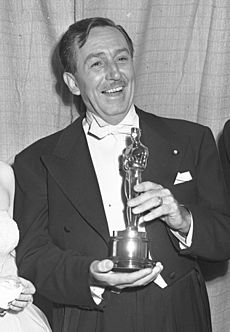
Walt Disney received 59 Academy Award nominations. He won 22 of these awards. Both of these numbers are records. He was nominated for three Golden Globe Awards. He did not win them, but he received two Special Achievement Awards. These were for Bambi (1942) and The Living Desert (1953). He also received the Cecil B. DeMille Award.
He was nominated for four Emmy Awards. He won one for Best Producer for the Disneyland television series. Several of his films are kept in the United States National Film Registry. This means they are "culturally, historically, or aesthetically significant." These films include Steamboat Willie, The Three Little Pigs, Snow White and the Seven Dwarfs, Fantasia, Pinocchio, Bambi, Dumbo, and Mary Poppins.
In 1998, the American Film Institute listed the 100 greatest American films. Snow White and the Seven Dwarfs was number 49. Fantasia was number 58.
In February 1960, Disney received two stars on the Hollywood Walk of Fame. One was for his movies and the other for his TV work. Mickey Mouse got his own star in 1978. Disney was also added to the Television Hall of Fame in 1986. In December 2006, he was inducted into the California Hall of Fame. He was the first person to get a star on the Anaheim/Orange County Walk of Stars in 2014.
The Walt Disney Family Museum says he received over 950 honors from around the world. He was made a Chevalier in France's Légion d'honneur in 1935. In 1952, he received France's highest artistic award. Other awards came from Thailand, Germany, Brazil, and Mexico.
In the United States, he received the Presidential Medal of Freedom in 1964. In 1968, he was given the Congressional Gold Medal after his death. He also received the Showman of the World Award. In 1955, the National Audubon Society gave him the Audubon Medal. This was for helping people understand nature through his True-Life Adventures films.
A minor planet discovered in 1980 was named 4017 Disneya. He also received honorary degrees from Harvard, Yale, the University of Southern California, and the University of California, Los Angeles.
Walt Disney Quotes
- "The four Cs of making dreams come true: Curiosity, Courage, Consistency, Confidence."
- "There is no magic in magic, it's all in the details."
- "Just make sure you never do less than your best."
- "Happiness is a state of mind."
- "If you can dream it, you can do it."
- "The difference in winning and losing is most often not quitting."
Related pages
- The Walt Disney Company
- Walt Disney Pictures
- Roy E. Disney
- Michael Eisner
- List of Disney animated movies
- Disney+
- Disneyland
Images for kids
-
Roy O. Disney finished the building of Disney World
-
Display case in the lobby of The Walt Disney Family Museum showing many of the Academy Awards won by Disney
See also
 In Spanish: Walt Disney para niños
In Spanish: Walt Disney para niños


